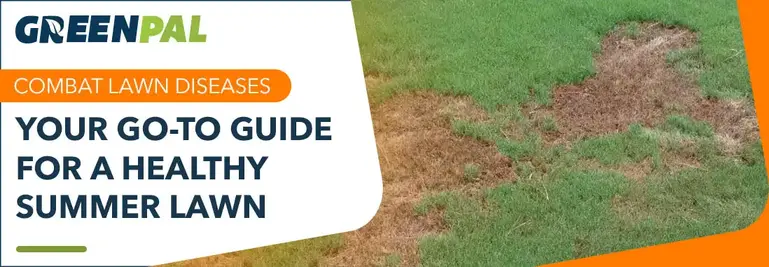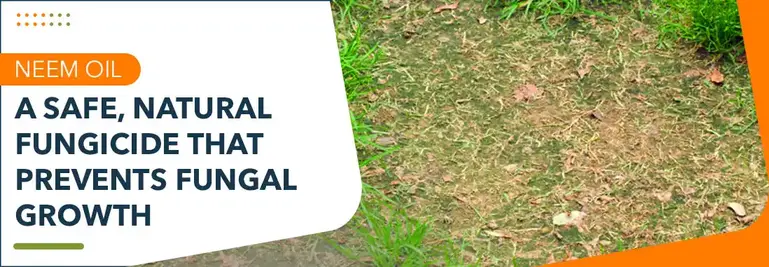The helpful guide you need to combat lawn diseases

We all want our lawns to look great for the summer. But lawn diseases may have different plans. Whether your lawn already suffers from lawn diseases or you're worried about the heat and humidity of the summer season inviting diseases onto your grass, we've got you covered. Let’s start with the basics.
Key Takeaways
|
|
|
|
|
|
What are Lawn Diseases?
Put simply, lawn diseases are when your grass is sick. Just like the human body sometimes finds itself under the weather, lawns do, too. Lawn diseases can compromise your lawn's health when given the right conditions. So, it's essential to know what preventive measures to take. It's also crucial to identify lawn diseases and eliminate them should they appear.
Many lawn diseases are caused by fungi, bacteria, or viruses that attack grass. These diseases cause lawns to discolor, grow patchy, or, in the worst cases, kill your grass. Heat and humidity may make things worse.
Summer often provides the needed conditions for diseases to increase, so it is essential to stay on guard. Identifying the symptoms early and dealing with them promptly will ensure that your lawn remains green all summer and beyond.
Understanding Common Lawn Diseases


Brown Patch
Brown Patch is a disease stemming from heat and humidity. The patches are often brown and irregular in shape. A dark brown border is also common. Excessive thatching and over-fertilizing prove a solid recipe for Brown Patch to do its worst. It affects common grasses, including some of the following:
Bentgrass
Tall fescue
Zoysiagrass
Perennial ryegrass
Kentucky bluegrass
St. Augustinegrass
Bermudagrass
Dollar Spot
The Dollar Spot fungus causes small, silver dollar-sized spots that enlarge and merge into patches of diseased grass. According to the NC State Extension, it "begins to grow and infect susceptible grasses in the spring when night temperatures exceed 50°F, even though symptoms of the disease may not appear until later in the spring or early summer."
This pathogen needs continuous wet and damp conditions (think 10 to 12 hours). Heavy dews meet that need and so do a ton of rain and overcast conditions. Dollar Spot remains active throughout the summer in many parts of the nation but becomes less of a threat when temperatures exceed 90 degrees.

Pythium Blight
Pythium Blight is another lawn disease that's bad news. With the right conditions, affected spots may come together — taking over large swaths of lawn even overnight. Pythium Blight, also called grease spot, is a severe fungal disease characterized by greasy, water-soaked areas that quickly brown and die. The disease is most damaging in hot, humid weather and is prevalent in poorly drained soils.
It often occurs in June, July, and August when nighttime temperatures remain high. All grasses are susceptible to variants of Pythium Blight; Kentucky Bluegrass, Perennial Ryegrass, Tall Fescue, Fine Fescue, Creeping Bentgrass, Annual Bluegrass, and Annual Ryegrass are some of the primary grasses experts see affected by this lawn disease.
Improved Bermudagrass cultivars have shown signs of resistance to it. Still, chances are, the only way to truly remain safe is to avoid overwatering (definitely don't water at night) and not overdo it on the fertilizer. High nitrogen content is another force multiplier of this lawn disease.
Keep some contact fungicides on hand to help catch it as early as possible, or hire a pro to deal with this rapidly spreading lawn disease.
Rust Disease
Rust Disease occurs almost exclusively on Kentucky Bluegrass and Perennial Ryegrass, according to Turfgrass Science at Purdue University.
This lawn disease appears as orange or yellow powdery spores on the grass blades. It is common on distressed, slow-growing lawns, with a potential for rapid infestation occurring in late summer. Low nitrogen, long evening dew periods, shade, poor grass growth, compaction, and temperatures between 50 to 60 degrees create the perfect recipe for Rust Disease.
To help prevent this lawn disease follow these three steps:
Apply small amounts of nitrogen to trouble spots.
Mow the area regularly.
Avoid watering at night.

Prevention Strategies for Lawn Diseases
Keeping your lawn free from diseases involves following the proper protocols during the growing season and corrective measures when problems arise. Maintaining the correct mowing height is crucial.
It's best not to cut your lawn below three inches.
When you cut a lawn any lower than three inches, you risk blades striking the ground, which can kill the lawn in that spot. Also, the taller the grass, the more water a lawn retains. Of course, if you let the grass get too long, the water retention will make cutting the lawn more challenging.
But, cutting the lawn too low can lead to a water-deprived lawn. A lawn only one and a half inches tall will hardly stand a chance against drought. Maintaining a lawn between 3 and 5 inches is ideal for water retention.
All of this is important when we consider how deep the roots of our grasses grow. Typically, roots grow around three times deeper than the typical grass height.
So, consider some of the following measurements:
A one-inch lawn will have roots around 3 inches deep.
Two-inch high grass will have roots around 6 inches deep.
Getting the math down? Three inches equals around 9 inches deep.
As you can imagine, roots that are 9 inches deep are much more likely to receive nutrients and survive adverse conditions than only 3 inches deep roots.
Also, mower blades should be kept sharp to prevent grass-tearing. These tears can create openings for pathogens. Cut no more than a third of the blade length at any time.
It's also important to water your lawn correctly. Water in the morning to give the grass time to dry before nightfall, and water deeply and infrequently to encourage root growth and support the grass to stay healthy. Overwatering and watering at night can leave the grass wet for an extended period, encouraging fungus growth. Use a soaker hose or drip irrigation system to water deeply and evenly.
You'll need to develop a fertilization schedule that's moderately balanced to help keep your lawn healthy. Slow-release fertilizers typically distribute nutrients over a more extended period and are better than fast-release fertilizers for providing consistent nutrients throughout the summer. Over-fertilization encourages lush, soft growth prone to disease, while properly fertilized grass is more robust and less susceptible to infections. Get a soil test for nutrient deficiencies as well.
A lawn that is built on healthy soil will be more resistant to disease. Aeration improves soil drainage and reduces compaction, which helps prevent diseases.
Dethatching removes the thick layer of dead grass and organic matter in which fungi can grow. Adding organic matter increases soil structure and health, supporting vigorous grass growth. To improve soil microbial activity and nutrient availability, consider topdressing with a thin layer of compost. At the end of the day, the way you care for your lawn is the most effective treatment option for preventing lawn diseases.

Treatment Options for Lawn Diseases
When prevention fails, you must know which treatments to treat lawn disease properly. Treatments can be natural or chemical, depending on the severity of the problem. For many, hiring a lawn care professional is the best option.
Time is of the essence to remedy lawn diseases, so getting help to identify and eradicate a summer lawn disease is a wise choice.
That said, here are a few ways to fight back against a lawn disease plaguing your yard:
Chemical Treatments
Fungicides fight severe infections. You'll want to select a fungicide that will treat the specific type of lawn fungus you are dealing with. Broad-spectrum fungicides treat multiple diseases, but there are products made to tackle particular lawn diseases. Make sure to read the label for application rates and application times.
Wear protective gear to reduce exposure to chemicals. Keep pets and children off the treated lawn until dry, and store fungicides in a safe place where children and pets cannot access them.
Natural Remedies
While chemical fungicides often provide the most effective treatment methods, natural treatments offer an eco-friendly way to manage lawn fungus.

Some options include:
Neem Oil: This natural fungicide is used against a wide array of lawn diseases, and this spray is safe for pets and children. It prevents fungal growth and should be applied as a foliar spray, covering the affected areas.
Bicarbonates: Since 1933, baking soda has proved its worth as a fungicide. Recent research says to exercise caution. Baking soda can help stop the spread of plant diseases but can also be toxic to plants. Other bicarbonates, like potassium bicarbonate and ammonium bicarbonate, may offer better, safer results.
Again, the best remedy is proper mowing, fertilizing, watering, and general lawn care. Established populations of pathogens may present recurring issues regardless of measures to combat them, so prevention provides the best option.
Quick Summary
Lawn Disease |
Causes |
Symptoms |
Affected Grasses |
Prevention Tips |
Brown Patch |
Heat, humidity, excessive thatching, over-fertilizing |
Brown, irregular patches with dark borders |
Bentgrass, Tall Fescue, Zoysiagrass, Perennial Ryegrass, Kentucky Bluegrass, St. Augustinegrass, Bermudagrass |
Avoid over-fertilizing, manage thatch, improve air circulation |
Dollar Spot |
Continuous wet/damp conditions, heavy dews, rainy/overcast weather |
Small, silver dollar-sized spots that merge into patches |
Bentgrass, Kentucky Bluegrass, Fine Fescue, Perennial Ryegrass |
Maintain proper watering, avoid excessive nitrogen, improve drainage |
Pythium Blight |
High humidity, poor drainage, overwatering, high nitrogen |
Greasy, water-soaked areas that brown and die |
Kentucky Bluegrass, Perennial Ryegrass, Tall Fescue, Fine Fescue, Creeping Bentgrass, Annual Bluegrass, Annual Ryegrass |
Avoid overwatering, water in the morning, use contact fungicides |
Rust Disease |
Low nitrogen, long evening dew periods, shade, poor grass growth, compaction |
Orange or yellow powdery spores on grass blades |
Kentucky Bluegrass, Perennial Ryegrass |
Apply small amounts of nitrogen, mow regularly, avoid watering at night |
Lawn diseases mean your yard is sick. They look bad and harm the overall health of your grass. To prevent lawn diseases, follow best practices and hire a professional if you cannot provide the care needed to keep your lawn in good shape.
In many areas of the nation, summer is when plant pathogens thrive. If a lawn disease plagues your yard, take immediate action. Some lawn diseases, like Pythium Blight, can rapidly harm your lawn even within 24 hours.
With the right know-how, you can keep your lawn healthy and disease-free.





 Share
Share




.webp)







